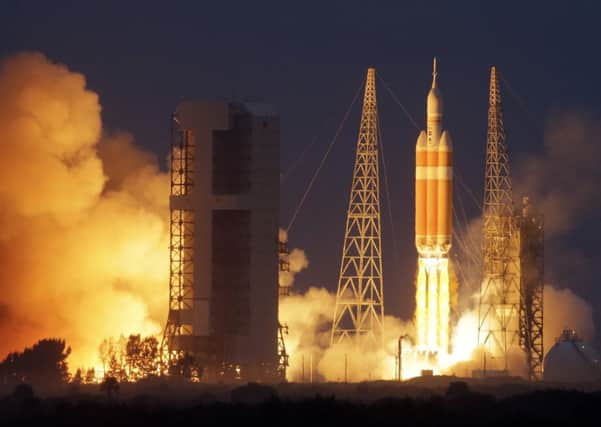Nasa Orion mission hailed as first day of Mars era


The unmanned test flight ended just four hours after it began and achieved at least one record – flying further and faster than any capsule built for humans since the Apollo moon programme.
“There’s your new spacecraft, America,” Mission Control commentator Rob Navias said as the Orion capsule neared the water 270 miles off Mexico’s Baja peninsula.
Advertisement
Hide AdAdvertisement
Hide AdMr Navias called the journey “the most perfect flight you could ever imagine”.
The Orion capsule was blasted onto space by a Delta IV-Heavy rocket from Cape Canaveral at 7.05am local time.
Nasa is counting on future Orions to carry astronauts beyond Earth’s orbit, to asteroids and ultimately the grand prize: Mars.
The agency reported many positive results, saying onboard computers were unaffected by high radiation in space. The capsule reached a peak altitude more than 14 times further from Earth than the International Space Station.
No spacecraft designed for astronauts has gone so far since Apollo 17, Nasa’s final moon shot, 42 years ago.
Nasa needed to send Orion that high in order to set the crew module up for a 20,000mph, 2,200C re-entry. That was considered the most critical part of the entire flight – testing the heat shield, the largest of its kind, before humans climb aboard.
In 11 minutes, Orion slowed to 20mph at splashdown, its final descent aided by eight parachutes deployed in sequence.
A crew on board would have endured as many as 8.2Gs, or 8.2 times the force of Earth’s gravity, twice the G-force of a returning Russian Soyuz capsule, according to Nasa.
Advertisement
Hide AdAdvertisement
Hide AdEarth shrank from view through Orion’s capsule window during its trip out to space, and images were relayed to Earth. Its return was recorded by an unmanned drone flying over the recovery zone.
Helicopters then relayed pictures of the crew module bobbing in the water. Three of its five airbags deployed properly, enough to keep the capsule floating upright.
The US Navy recovered the spacecraft 630 miles southwest of San Diego, where it was due to be brought to land.
All the parachutes – which were part of the equipment being tested – did their job, but only two of the eight were recovered.
Orion’s debut was designed to be brief – just two orbits of Earth. Nasa is now “one step closer” to putting humans aboard Orion, said agency administrator Charles Bolden Jr. He called it “Day One of the Mars era.”
However, a Mars mission may not be launched until the 2030s because new technologies needed have not been produced yet.
The atmosphere at Kennedy Space Centre was reminiscent of the shuttle-flying days, but more upbeat than that programme’s last mission in 2011.
Astronaut Rex Walheim was aboard the final shuttle flight and joined dozens of colleagues on hand for the Orion launch.
Advertisement
Hide AdAdvertisement
Hide AdHe was positive about Orion’s future in sending crews to Mars and the importance of becoming what he called “a multi-planetary species”.
He added: “You have that excitement here at the Kennedy Space Centre and it’s tinged with even more excitement with what’s coming down the road.”
To push Orion further out on future flights, NASA is developing a “megarocket” known as Space Launch System or SLS.
The first combination of Orion and SLS will fly in around four years time, again unmanned, although it will be capable of carrying four astronauts on long hauls and as many as six on three-week missions.